
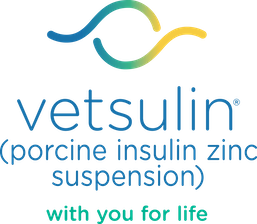
VetPen® Administration
Learn More About Dosing & Administration
The First Insulin Pen for Cats
VetPen® from Merck Animal Health is the first veterinary insulin pen for use in the treatment of diabetes mellitus in cats. To avoid dosing errors, VetPen® must be used with 40 IU/mL, 2.7 mL Vetsulin® cartridges.VetPen is available in 2 sizes: 8 IU VetPen with dosing increments of 0.5 IU and 16 IU VetPen with dosing increments of 1 IU. Vetsulin® (porcine insulin zinc suspension) (2.7 mL) cartridges are available in boxes of 10.
Advise pet owners not to reuse VetPen needles. After a single use, needles should be disposed of in approved sharps or biohazard containers.
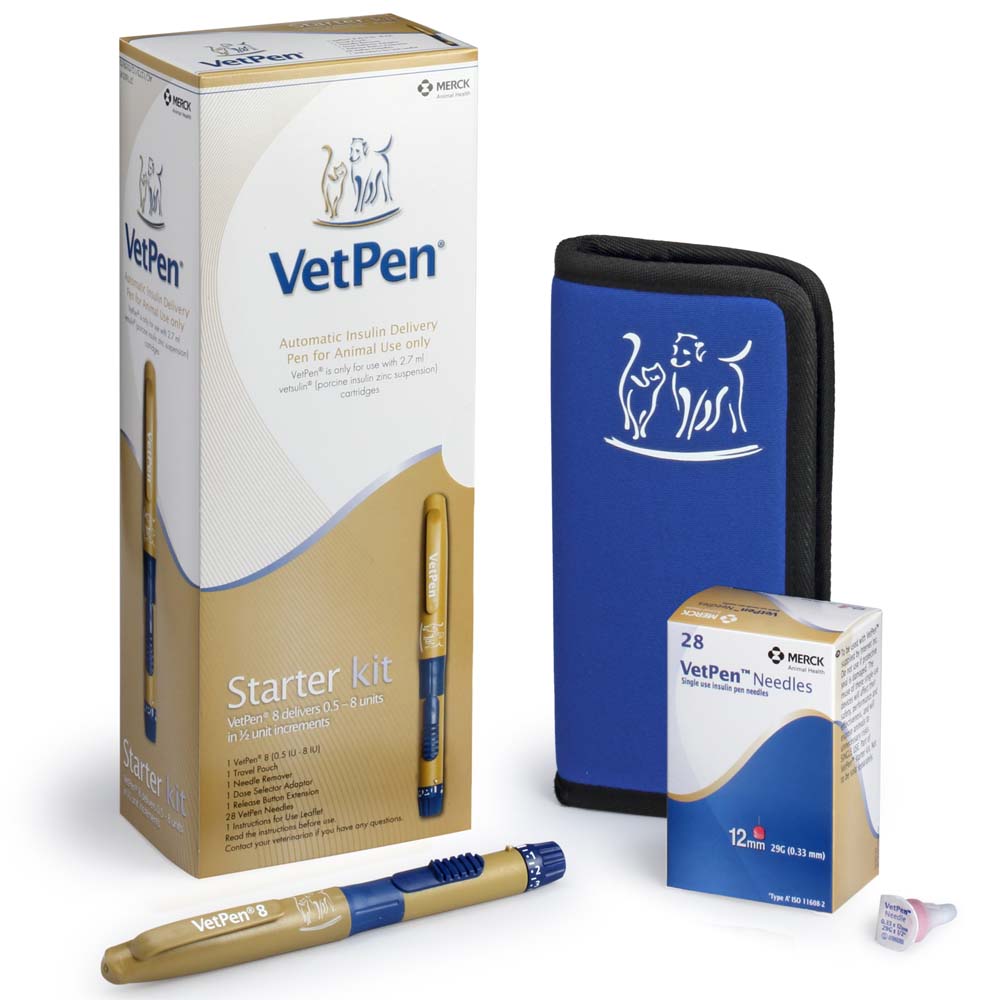
How to Use VetPen®
How to Use VetPen®
- Wash your hands.
- Remove cap and unscrew body from cartridge holder.
- Ensure plunger is retracted. If it is not, rewind plunger to retract.
- Insert cartridge after shaking thoroughly.
- Screw cartridge holder and body together gently but firmly.
- Peel off protective film and screw new VetPen needle onto cartridge holder.
- Remove outer protective needle cap.
- Replace the pen cap then shake the pen until a homogenous, uniformly milky suspension is obtained.
Priming the VetPen®
It is important to remove the air from the cartridge (prime) before use to avoid injection of air and ensure proper dosing.
- Dial one unit on the dose selector and remove the needle cap and the inner protective needle sheath.
- Hold the pen with the needle pointing up and tap the pen gently with your fingers to push any air bubbles to the top.
- Push down the release button and hold until the arrow on the body returns to the starting line on the dose selector.
- Repeat steps 1-3 until a strong, steady stream or jet of insulin appears at the needle tip. Expect to expel at least 8 units of air.
- Push down the release button and hold until the arrow on the body returns to the starting line on the dose selector.
- Check that the cartridge is free of air bubbles by viewing the cartridge through the VetPen window and inverting or tilting the pen.
- Ensure the arrow on the VetPen points to the start line on the dose selector, then dial the number of units prescribed.
- The VetPen is now ready for use.
Giving the Injection
- Injection should be given under the skin, 3/4 to 2 inches from the middle of your cat’s back, varying from behind the shoulder blades to the middle of the back region and alternating sides.
- Remove needle cover and protective caps. Insert the needle, then push the release button toward the pen needle and hold it in place until the start line on the dose selector returns to the arrow on the pen body. Take care to not impede the motion of the dose selector.
- After the dose selector has returned to the start line, wait a minimum of 5 seconds before withdrawing the needle from the skin.
- If insulin leaks out of the pen after injection, check the cartridge for small air bubble using the VetPen window. Do not attempt to re-dose.
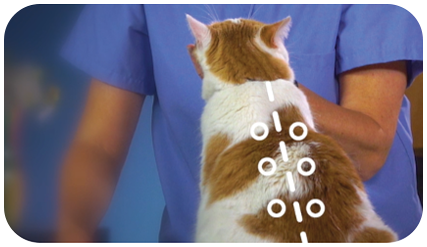
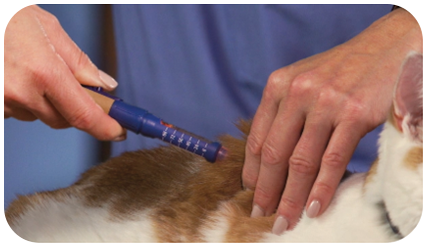
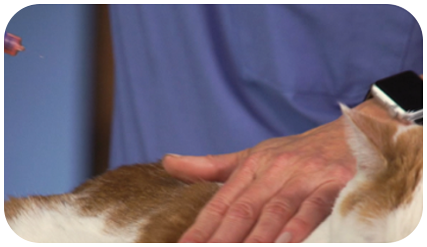
Injection Tips
- If only a partial dose is given, do not attempt to re-dose. Wait and give your cat its usual dose at the next injection time.
- If you over-dial, never wind back the dose selector. Dispose of the insulin and dial up the correct dose.
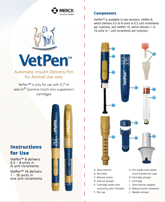
Downloadable VetPen® Instructions
Use this PDF to help clients prepare and administer Vetsulin to dogs using VetPen.
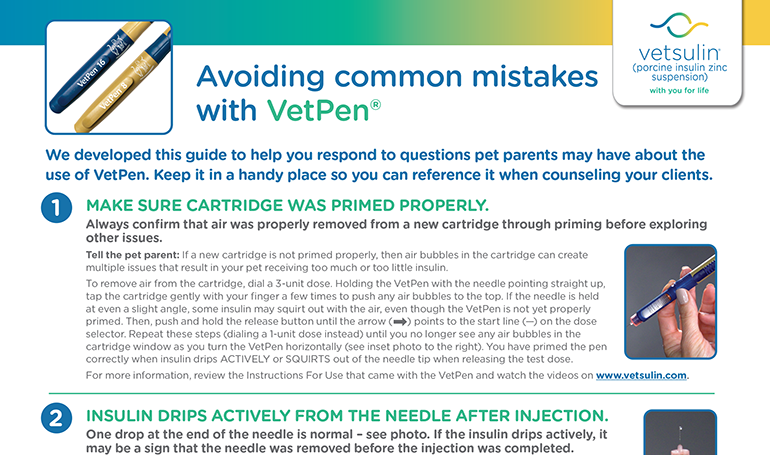
Frequently Asked Questions about VetPen®
Avoiding common mistakes with VetPen
No items to show.
Safety Information
Important Safety Information
Vetsulin should not be used in dogs or cats known to have a systemic allergy to pork or pork products. Vetsulin is contraindicated during periods of hypoglycemia. Keep out of reach of children. As with all insulin products, careful patient monitoring for hypoglycemia and hyperglycemia is essential to attain and maintain adequate glycemic control and prevent associated complications. Overdosage can result in profound hypoglycemia and death. The safety and effectiveness of Vetsulin in puppies and kittens, breeding, pregnant, and lactating dogs and cats has not been evaluated. See package insert for full information regarding contraindications, warnings, and precautions.
User Safety Warning
For use in animals only. Keep out of the reach of children. Avoid contact with eyes. In case of contact, immediately flush eyes with copious amounts of water for at least 15 minutes. Accidental injection may cause clinical hypoglycemia. In case of accidental injection, seek medical attention immediately. Exposure to the product may induce a local or systemic allergic reaction in sensitized individuals.
Help Your Practice Manage Diabetes Mellitus
Check out these tools and resources to help manage feline diabetes.

Blood Glucose Curve Generator
Create a blood glucose curve to monitor and evaluate diabetes treatments.

Client Discharge Form
Create a customized, printable form for clients about their new diagnosis.

Diabetes Resources
Access online tools and more to support staff and pet parents.
No items to show.
Learn More About Dosing & Administration
Important Safety Information:
Vetsulin® should not be used in dogs known to have a systemic allergy to pork or pork products. Vetsulin is contraindicated during periods of hypoglycemia. Keep out of reach of children. As with all insulin products, careful patient monitoring for hypoglycemia and hyperglycemia is essential to attain and maintain adequate glycemic control and prevent associated complications. Overdosage can result in profound hypoglycemia and death. The safety and effectiveness of Vetsulin in puppies, breeding, pregnant, and lactating dogs has not been evaluated. See package insert for full information regarding contraindications, warnings, and precautions.
VetPen® User Safety Warning: For use in animals only. Keep out of the reach of children. Avoid contact with eyes. In case of contact, immediately flush eyes with copious amounts of water for at least 15 minutes. Accidental injection may cause clinical hypoglycemia. In case of accidental injection, seek medical attention immediately. Exposure to the product may induce a local or systemic allergic reaction in sensitized individuals.
References:
1. Martin GJ, Rand JS. Pharmacology of a 40 IU/ml porcine lente insulin preparation in diabetic cats: findings during the first week and after 5 or 9 weeks of therapy. J Feline Med Surg. 2001;3(1):23–30. 2. Vetsulin® (porcine insulin zinc suspension) [Freedom of Information Summary]. Millsboro, DE: Intervet Inc.; 2008. 3. Data on file, Merck Animal Health. 4. Graham PA, Nash AS, McKellar QA. Pharmacokinetics of porcine insulin zinc suspension in diabetic dogs. J Small Anim Pract. 1997;38(10):434–438. 5. Martin GJ, Rand JS. Pharmacokinetic and Pharmacodynamic Study of Caninsulin in Cats with Diabetes Mellitus. 2000: Internal Study Report. 6. Feldman EC, Nelson RW. Canine and Feline Endocrinology and Reproduction. 3rd ed. St. Louis, MO: Saunders; 2004:539–579. 7. Tennant B, ed. BSAVA Small Animal Formulary. 4th ed. Gloucestershire, UK: British Small Animal Veterinary Association; 2002. 8. Feldman EC, Nelson RW. Canine and Feline Endocrinology and Reproduction. 3rd ed. St. Louis, MO: Saunders; 2004:486–538. 9. Reusch C. Feline diabetes mellitus. In: Ettinger SJ, Feldman EC, eds. Textbook of Veterinary Internal Medicine. 7th ed. St. Louis, MO: Saunders; 2010:1796–1816. 10. Nelson RW. Canine diabetes mellitus. In: Ettinger SJ, Feldman EC, eds. Textbook of Veterinary Internal Medicine. 7th ed. St. Louis, MO: Saunders; 2010:1782–1796. 11. Burgaud S, Riant S, Piau N. Comparative laboratory evaluation of dose delivery using a veterinary insulin pen. In: Proceedings of the WSAVA/FECAVA/BSAVA congress; 12–15 April 2012; Birmingham, UK. Abstract 121. 12. Burgaud S, Guillot R, Harnois-Milon G. Clinical evaluation of a veterinary insulin pen in diabetic dogs. In: Proceedings of the WSAVA/ FECAVA/BSAVA congress; 12–15 April 2012; Birmingham, UK. Abstract 122. 13. Burgaud S, Guillot R, Harnois-Milon G. Clinical evaluation of a veterinary insulin pen in diabetic cats. In: Proceedings of the WSAVA/FECAVA/BSAVA congress; 12–15 April 2012; Birmingham, UK. Abstract 45. 14. Davison LJ, Walding B, Herrtage ME, Catchpole B. Anti-insulin antibodies in diabetic dogs before and after treatment with different insulin preparations. J Vet Intern Med. 2008;22:1317-1325. 15. Banfield State of Pet Health 2016 Report. p 12-13.
